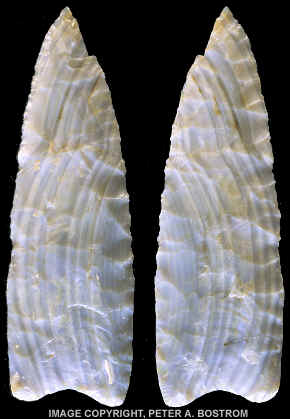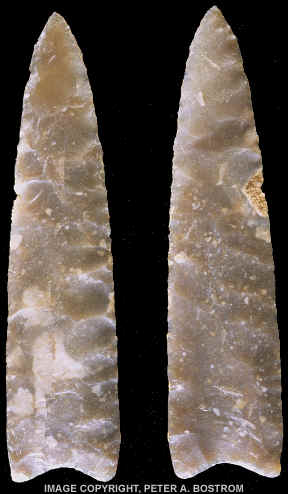|
|
|
Small ivory fragments were also found with the Drake cache. Dennis Stanford of the Smithsonian Institution began his investigation of the Drake site late, after it had already been well searched. But he did recover a hammerstone and more ivory fragments similar to the ones that had already been surfaced collected. The ivory fragments may have been foreshafts for Clovis projectile points or maybe even handles for Clovis knives. |
|
|
The oldest recognized culture in North America is
Clovis and, as would be expected, caches from this early period are
rare. Only seven examples from the western states have been scientifically described. The Anzick cache
from Montana is the largest with 100 pieces. The five other caches,
besides Drake, are Fenn (unknown provenance--either Utah or Wyoming,
1902?) Simon cache (Idaho, 1961), Busse cache (Kansas, 1963), Crook
County cache (Wyoming, 1978) and the Richey cache (Washington, 1987). |
|
|
Prehistoric caches of two or more stone artifacts are commonly found in North America. Most of them are discovered by the general public in a number of different ways. Caches are found by farmers who plow their fields, construction workers who build buildings & roads or even by fishermen who walk along eroding stream and river banks. In-other-words they can be found anywhere the ground has been disturbed by man or nature. |
|
|
Anzick is one of the few Clovis caches that contained organic material and the only one that seems to show good evidence for the purpose of the cache. The Anzick Clovis cache from Montana was found with a child burial. In this case the artifacts seem to have been left there as offerings to the dead, as grave goods. |
|
| CONTINUE ON TO PAGE THREE | |
|
"REFERENCES"
1990,
Yeager, C.G. editor, "History of the Stone Age Fair" pages front
cover& back of front cover. |
|



